
Contents
1. Facts about Lord Shiva – Origin and meaning
A. The word Shiva (शिव) has been derived by reversing the letters of the word vash (वश्). Vash means to enlighten; thus the one who enlightens is Shiva. Shiva is absolute, self-radiant. He remains radiant and also illuminates the universe.
B. He is the auspicious and prosperity-bestowing principle.
2. Facts about Lord Shiva – Some other Names
2.1 Shankar
In ‘शं करोति इति शंकर: ।’ sham (शं) means welfare and karoti (करोति) is the doer. Thus the one who is responsible for one’s welfare is Shankar.
2.2 Mahankaleshvar
The presiding deity [Kshetrapaldev (guardian deity of the territory)] of the entire universe is Kalpurush (one who is beyond time) meaning Mahakal (Mahankal). Hence He is also named Mahankaleshvar.
2.3 Mahadev
At the time of creation and activity of the universe basically there are three thoughts – absolute purity, absolute knowledge and absolute spiritual practice. The deity who possesses all these three attributes is referred to as the deity of all deities, Mahadev.
2.4 Bhalachandra
Bhal (भाल) means the forehead. The one who adorns the moon (chandra) on His forehead is Bhalachandra (भालचंद्र). Ganapati, the son of Shiva also has Bhalachandra as one of His Names.
2.5 Karpurgour
Shiva’s complexion is white akin to that of camphor (karpur). Hence the Name Karpurgour.
2.6 Stenapati
Sten (स्तेन) means a thief. Stenapati (स्तेनपति) thus means the caretaker of thieves. In ancient times temples of Shiva were located on the outskirts of the village. They were the hide-outs of robbers. It was here that robbers distributed their share of stolen booty amongst themselves and even left one share for Lord Shiva!
2.7 Pingalaksha
The words pingal (पिंगल) and aksha (अक्ष) make up the word Pingalaksha (पिंगलाक्ष). The bird named pingal, a type of owl, is able to perceive the past, present and future. Since Lord Shiva has the same quality He is referred to as Pingalaksha.
2.8 Nilkantha and Ashutosh
3. Facts about Lord Shiva – Special features
God created the universe from the five deities (principles) – Prajapati, Brahma, Shiva, Vishnu and Minakshi. These deities possess all the characteristics of God besides their own special features. According to the Shaiva sect Lord Shiva in the nirbij superconscious state (samadhi) is Shiva’s unmanifest form, that is in other words The Supreme God. According to them Shiva in meditation is God and the one dancing or playing a game of dice with Parvati is the Great Illusion (Maya). [Among the Vaishnavites Sheshashayi (Vishnu resting on the serpent Shesh as His couch) or Anantashayani Vishnu is Vishnu’s unmanifest form, that is The Supreme God. Their devotee loving Vishnu is God and the one with Lakshmi is the Great Illusion.] The characteristics vary with the form. The features of God are given in ‘Science of Spirituality : Vol. 7 – Supreme God, God, Incarnations and Deities’. The other special features of Shiva are enlisted below.
3.1 Physical features
Just as the sun is the focal point of the solar system and the soul that of the body, the focal point of divine consciousness (chaitanya) in every object and pure particles (pavitrakas) is ga-aun. The flow from which ga-aun originates is gan (गं) gaha (ग:) – Ganga (गंगा). Ga-aun flows from Shiva’s head. This itself is called the descent of the Ganga from Shiva’s head.
The cohesion of ga-aun constitutes gans (attendants). According to the science of Yoga, gan represents the eight demigods (ashtavasu) or the eight guardian deities (dikpal) of the eight directions (dishas). The origin of the guardian deities is also ga-aun. The guardian deities comprise of the angles of the directions from which ga-aun flows. One goes towards God and grows through the medium of directions alone. Ganapati is the presiding deity of various ga-aun; hence He is called ‘Ganapati’, the master of pure particles.
Since the river Ganga has a fraction of the principle of the spiritual Ganga no matter however much polluted it becomes, its purity is perpetually retained. Hence if compared to any other water in the world the water from the Ganga is the most pure. This is realised not only by those who can perceive from the subtle dimension but also by scientific researchers. More information on the Ganga is given in ‘Science of Spirituality : Vol. 9B – Shakti (Divine Energy)’.
Shiva adorns the chandra (moon) on His forehead. The words chandramas (चंद्रमस्) – chandrama (चंद्रमा) – chandra have been derived from the three words cha (च), Indra (इंद्र) and [muhu (मु:)] mas (मस्) which mean the state of cohesion. This means blending with something along with Indra. (Indra’s frequencies are superior to those of other deities.) The chandrama has absorbed frequencies from Prajapati, Brahma, Shiva, Vishnu and Minakshi and imparts them to others along with Indra. The frequencies arising from Prajapati, Brahma, Shiva, Vishnu and Minakshi blend with each other and produce a number of groups of frequencies. Prajapati, Brahma, Shiva, Vishnu and Minakshi are unmanifest (nirgun); but Their frequencies contain the three components (gunas). The point where the three frequencies that is affection (mamata), mercifulness (kshamashilata) and motherly love (vatsalya) originate is referred to as the chandra (moon). Thus one can conclude that chandrama (the moon principle) is that state in which the three attributes of affection, mercifulness and motherly love are present. This is not the moon that we see in the sky. The moon in the sky contains a component of this chandra (moon).
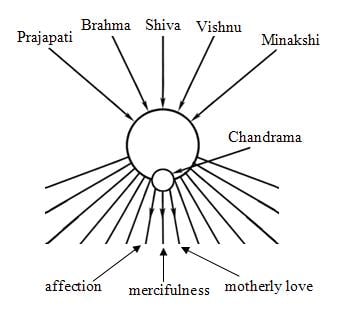 |
‘Alhadyati iti chandraha (आल्हादयति इति चंद्र: ।)’ is the only definition of the chandra (moon) described in all the texts giving the origin of words. (All other words have varied descriptions regarding their origin in different texts.)
- Shiva’s left eye is the first eye, the right eye is the second and the verticle one in the subtle form, just above the midpoint of the eyebrows is the third one. The upper eye is a representation of the combined energy of both the right and left eyes. It is also the greatest seat (mahapith) of extrasensory energy and is endowed with names such as Jyotirmath, Vyaspith, etc.
- Chandra, Arka and Vaishvanar are the three eyes of Lord Shankar. Arka is the sun from the ajanaj region while Vaishvanar is the sun from the karmadev region. Therefore Shankar can view everywhere in the universe. (Information on the ajanaj and karmadev regions is given in ‘Science of Spirituality : Chapter 25 – Composition of the Universe’.)
- Shankar is three-eyed means He can perceive events in the past, present and future as well.
- According to the science of Yoga the third eye means the Sushumna channel (nadi).
- One of the Names of Lord Shankar is Bhujangapatihari (भुजंगपतिहारी). Bhujang (भुजंग) means a serpent or pure particles (pavitrakas), pati (पति), the nurturer and hari (हारी), the one with a garland around His neck. Bhujangapatihari thus means the one who nurtures pure particles and wears them like a garland. Various serpents represent groups of pure particles. Though externally they appear like serpents, internally they are a kind of ladders. To make spiritual progress one has to climb up holding onto the tail of the serpent.Shankar adorns serpents at nine sites on His body – one on the head, one around the neck, one on each arm, one on each wrist, one around the waist and one on each thigh. This implies that His body is comprised of pure particles or that serpents of pure particles play all over the body of Lord Shiva who is universal in nature.
- The serpent is also considered as Shiva’s weapon. The nine serpents from the universe are also referred to as ‘Navanarayan’. The Navanaths have originated from these nine serpents. Information on Navanarayan and Navanaths is given in ‘Science of Spirituality : Chapter 12 – Vishnu, point – Some other Names’.
- Kartikeya, Jotiba, Ravalnath and Sabbu are deities in the form of serpents.
- A serpent is connected with all deities in some way or the other.
- A female serpent (nagin) is present in the body. It is called the kundalini (spiritual energy). [Refer ‘Science of Spirituality : Chapter 38 – Path of Activation of Spiritual Energy (Kundaliniyoga)’]. Five serpents wander in the body as five inner vital energies. One does not possess the other four serpents in the body. However they can be acquired through spiritual progress.
- The serpent is a representation of the God (Purush) principle. He is the deity who endows progeny.
Bhu (भू) – bhava (भव) means to take birth. As (अस्) – asma (अस्म) – ashma (अश्म) means ash. That which takes birth and blends with ash is called bhasma (भस्म). Bhasma is the ash of the one who is born. Shma (श्म) [sma (स्म)] means ash and shru (शृ) – shan (शन्) means scattered. So, the place where ash is scattered is the smashan (स्मशान), that is the crematorium. The earth is born from fire (the sun). All beings on the earth arise from and merge into its fire. The skull of man is associated with memories (smruti) of the earth. From outer space the shape of the earth resembles a skull. Ash contains the following three types of memories (smruti) from the time before birth to that after it.
- Yadnyasmruti: Memories of sacrificial fires (yadnyas) in the ajanaj region (lok) and the regions beyond it. (Refer ‘Science of Spirituality : Chapter 25 – Composition of the Universe’.)
- Parthivsmruti: Memories of death which are full of agony and sorrow, with reference to the earth and the seven nether regions.
- Tanmaysmruti: Memories of sacrifice (austerities) in context with the regions from the earth to the northern (Shiva) region and the southern (dakshin) region.
The three horizontal stripes of ash on the forehead of Lord Shankar represent these three memories. Ash projects the desires of a person. This shows how harmful desires are. The dhananjay vital energy of every dead being made up of the absolute earth element (pruthvi) surrounds the ash. (The universe has the mahadhananjay vital energy.) When a person is reborn this dhananjay vital energy re-enters the body. The frequencies emitted by ash are mostly a result of a painful death. The ash says, ‘Let go of ignorance. The physical body is not real. The happiness derived from it is fake. Do not get trapped in it’. Human ash is applied to a jyotirlinga. Pure ash is called holy ash (bhasma). Just as holy ash is an essential ingredient in ritualistic worship so also it plays a very important role in the Shaiva sect. It is considered as the semen of Lord Shiva. Special significance is given to the holy ash from the fireplace (agnikunda) of the Brahmans who perform the ritual of Agnihotra. The ash obtained after cremation of a corpse amidst chanting of mantras is called human ash (chitabhasma). Lord Shiva loves human ash. In Varanasi, the deity Vishveshvar is always smeared with human ash. Holy ash is of three kinds, namely shantikar, pushtikar and kamad. It cleanses sins. The Jabalshruti also quotes that it is also beneficial in acquiring knowledge of Brahman.
Vibhuti is another synonym for holy ash. It is used in tantra, mantra, black magic, etc. to guard the directions or as self-protection. The holy ash is invoked with mantrâs and is then applied to the forehead of the child or the sick person. Ashes (bhasma) of various kinds such as of iron, gold, pearl, diamond, etc. is used in Ayurveda. These are highly efficacious. However this is not revealed to people as it may frighten them.
Shiva adorns chains of rudraksha beads around the knotted bun of hair on His head, the neck, arms, wrists and waist.
G. Garment and the seat of tiger skin
The tiger (raja and tama components) is a symbol of cruelty. Shiva slayed such a tiger (that is destroyed the raja-tama) and made a seat from its skin.
3.2 Spiritual characteristics
A. The one performing severe austerities and the great yogi: Shiva is the only deity chanting The Lord’s Name continuously. He is always seated in a bandha or a mudra. His temperature rises due to heat generated by performing severe austerities; hence He uses the Ganga, the moon and serpents which endow a cooling effect and lives on the snow-capped Kailas mountain.
B. Short tempered: If Shiva stops His chanting by Himself He remains calm. However if someone disturbs His chanting [e.g. as was done by Madan (the deity of love)], the radiance generated by spiritual practice is suddenly expelled and since the person in front of Him cannot tolerate it, that individual is destroyed. This itself is referred to as ‘reducing to ashes by Shankar’s opening of the third eye’. The troublemaker is 100% distressed while Shiva is only 0.01% distressed. Because of this distress Shiva’s nadibandha stops but the posture is retained. Then Shiva performs the bandha once again.
C. The one who is willing to undergo any distress for the sake of imparting happiness to others: The poison generated during the churning of the celestial ocean (samudramanthan) was burning the entire world but no deity came forward to accept it. At that time Shiva drank that poison and saved the world from destruction. Ingestion of the poison turned His neck blackish-blue and He came to be known as Nilkantha (नीलकंठ); nil (नीळ) means blue and kantha (कंठ) means the neck.
D. The one who is easily appeased (Ashutosh)
E. The one willing to bestow any boon when appeased: Once when Shiva was pleased with Ravan not only did He gift him His wife but also His divine phallus (atmalinga) (soul). [Ravan himself wanted to become Shiva with that divine phallus.]
F. The one who has both deities and demons as His worshippers: Neither did demons like Banasur, Ravan, etc. worship Vishnu nor did Vishnu bestow boons upon any demon. However they worshipped Shiva who blessed them with a boon. Often He as well as other deities were in trouble because of these boons. Finally each time Vishnu would find a solution to these situations.
G. Master of the spirits: Since Shiva is the master of spirits, worshippers of Shiva are generally not possessed by them.
H. One possessing contrasting characteristics (acceptance and repulsion) simultaneously: He has the potential to create and bring about dissolution, also the combination of serenity-angrer, the moon (tranquility) – the third eye (radiance which reduces to ashes), sattvik (sattva predominant) – tamasik (tama predominant) temperaments, etc.
4. Facts about Lord Shiva – Mission
4.1 Creation of the universe
Shiva-Parvati are called ‘जगत: पितरो’, the parents of the world.
- Fifty-two sounds (letters), that is nadabijas or bijamantras were generated from the fifty-two notes emitted by Shankar’s small hourglass shaped drum (Damaru) from which the universe was created. Nad (नद) – nad (नाद) is the process of flowing continuously. The sound ‘da (द), da (द), dam (दम्)’ meaning ‘ददामि त्वं (I am giving you)’ was generated from these bijas of sound. It was as though Shiva assured the universe ‘I bestow you with spiritual knowledge, purity and penance’.
- Since Shiva is urdhvaretas He can create the universe with a mere resolve (sankalpa).
4.2 Jagadguru
‘ज्ञानं इच्छेत् सदाशिवात् । मोक्षं इच्छेत् जनार्दनात् ।’, means one should worship Shiva for spiritual knowledge and Janardan (Vishnu) for the Final Liberation (Moksha).
4.3 The one leading to the state beyond the three components (trigunatit)
Shankar destroys all the three components of Prakruti – sattva, raja and tama, that is ignorance simultaneously.
4.4 Mission according to the time (kal)
| Period | Name | Form / Mission |
| 1. Vedic period | Rudra (the one who makes one cry) |
Fearful form |
| 2. Post-Vedic period | Shiva | Mild form |
| 3. Puranic period (0 to 1000 A.D.) |
Mahesh | The deity responsible for dissolution in the trinity of Brahma, Vishnu and Mahesh. |
| 4. Post-Puranic period (after 1000 A.D.) |
Mahadev (the deity of all deities) |
The creator, sustainer and destroyer |
Reference: ‘Shiva’, published by Sanatan Sanstha

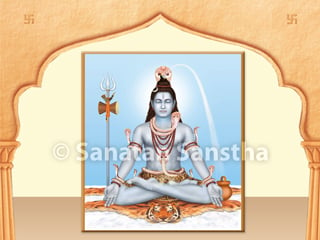
 Ritualistic worship of Shiva
Ritualistic worship of Shiva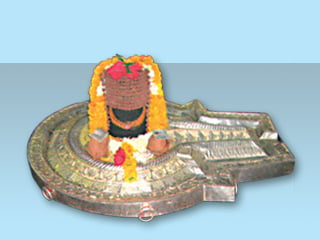 12 Jyotirlinga
12 Jyotirlinga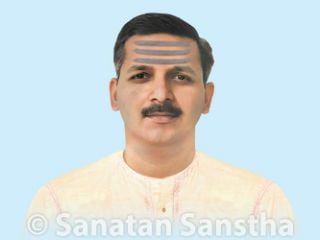 Bhasma
Bhasma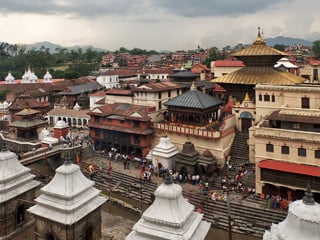 What is the concept of Final Liberation as per the Pashupat sect?
What is the concept of Final Liberation as per the Pashupat sect?